Debunking Stretching

Why bother stretching?
There are many different theories around when to stretch, when not to stretch, how to stretch and how long to hold the stretch. This blog will simplify the different types of stretches you can as well as guide you to the best stretching regimes to add to your exercise routine to keep your muscles working at their optimum.
Benefits of stretching:
You will be able to exercise for longer – Stretching loosens muscles, tendons and connective tissue, this reduces muscle fatigue which is what stops you exercising.
Improves quality of sleep – A regular routine of stretching and light exercise has been proven to give you a good night’s sleep in study on post-menopausal women.
Injury prevention – By supplying more nutrients to muscles pre and post exercise, it will reduce post work out soreness and speed up recovery time.
Improves blood circulation – Not just great for muscles but for overall health. Stretching reduces heart rate and high blood pressure by supplying fresh blood full of nutrients around the body.
Improves athletic performance – Tight muscles during exercise can really hold you back. Relaxed muscles can help you perform at your peak and the muscles are more available for your exercise.
Let’s cover the different types of stretches:
Static Stretching:
This is the most common stretching technique. It is achieved by placing the target muscle group in its longest position and holding for 30 seconds or longer. It can then be categorised as active if force is applied by the individual for greater intensity or passive if force is applied by an external force (e.g. weights) to increase intensity. In yin yoga philosophy holding stretches for 2 minutes or more allows the stretch to surpass the muscle belly and begin to elongate muscle tendons where the muscles insert to the bones creating an even deeper stretch.
Dynamic Stretching:
Dynamic stretching uses continuous movement patterns that simulate an exercise or sport. It is usually used when training for a specific exercise or activity rather than general stretching. For example a golfer would spend time doing, exaggerated thoracic twists to enable them to have great range of movement in full swing.
Ballistic Stretching:
Ballistic stretches use repetitive bouncing movements to stretch the targeted muscle group. There is more risk of injury with this type of stretching as the stretch reflex is triggered as well as the fast paced motion to full muscle range. However, if done safely (i.e. without pushing the body too far and too quickly into full range) and then proceeded with static stretching, ballistic stretching can be effective. We advise to first seek advice of a professional trainer before trying these ones at home!
Proprioceptive Neuromusclar Facilitation (PNF):
This stretching technique utilizes on the use of autogenic and reciprocal inhibition, this is through the muscles contracting, relaxing and stretching all within the same exercise. The reciprocal inhibition kicks in when the muscle is stretches to its full range after it has been contracted and used with force. This exercise is best performed with the help of a professional trainer so as not too overstretch and cause injury.
Active Isolated Stretching (AIS):
This technique targets a specific muscle group and is only held for 2 seconds. It is repeated for several repetitions, increasing the point of resistance gradually each time. Usually this technique is used for a strength training regimen and has a specific number of sets and repetitions.
Myofacial Release:
This technique targets the flexibility of facia, you may have heard of fascia before (pronounced fash-ah). It is a thickly interlaced connective tissue which surrounds the body’s muscles and organs and bonds all the compartments of the body. When we are doing this technique we are targeting the facia that sits between the muscles and the skin, often accessing the underlying muscle during the process. A foam roller is a great tool for this type of stretching, placing it over an area of 5-15cm for 30 to 60 seconds and performing back of forth movements. The person’s pain tolerance will define the amount of pressure applied to the area
Now that we know the different types of stretching, when are the best time to stretch?
Stretching before and after exercise can create flexibility in joints and muscles which may help reduce risk of injury and boost performance. It is recommended to perform light gentle stretches before exercise and spend most of your stretching time post exercise when the muscles are warmer and more malleable.
For at home stretches or if you are new to stretching, we recommend starting with static stretching and myofascial stretching as they are very accessible for everyone and have low chance of injury.
If you are training regularly and need to boost your stretching game, speak with your trainer about the other types of stretches mentioned here.
if you are not performing any particular exercises at the moment, stretching before bed is a great way to wind down after a long day and can help with sleep. Also considering yoga or pilates to incorporate stretching into your daily routine is another great option.
Feel free to drop into the centre to chat more about the best options for your stretching routine!
Claire Adamson
Myotherapist





